High-efficiency furnaces can help you save money on your energy bill. But unlike conventional furnaces, they can produce condensation due to their second heat exchanger.
That’s why high-efficiency units are often called condensing furnaces. Whereas traditional furnace systems can be called non-condensing furnaces.
If your high-efficiency furnace has a water leak, then you most probably have a clogged condensate drain hose or a clogged drain line. Sometimes, even though you have a conventional furnace, you might have a condensation problem from different sources. The problem should be resolved immediately.
This article covers everything you need to know about a furnace leaking water in the winter. It also includes instructions for fixing the problem.
Let’s get into it.
How to fix a furnace leaking water in the winter
The first thing you should do is figure out whether you have a high-efficiency or a conventional furnace. That’s because the type of furnace that you have will influence the potential causes of your leak.
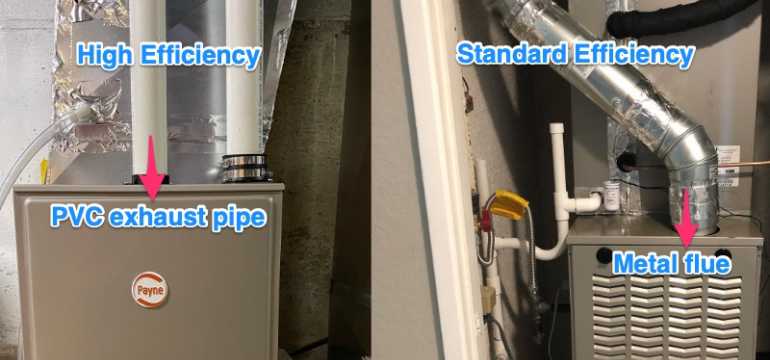
The easiest way to make this distinction is by looking at your exhaust pipe. If the pipe is made out of PVC, then it’s a high-efficiency furnace. If it’s made out of metal, then it’s typically going to be a standard-efficiency furnace.
Why a high-efficiency furnace may leak water
High-efficiency furnaces produce condensation while running. This happens when the furnace releases exhaust gases.
This condensation can create a significant amount of moisture on the PVC exhaust pipe. That’s why these systems have drains or condensation pumps to deal with extra water.
But sometimes, these built-in systems don’t work properly. And that’s when a water leakage from condensation can occur.
Condensate drain hose and drain line
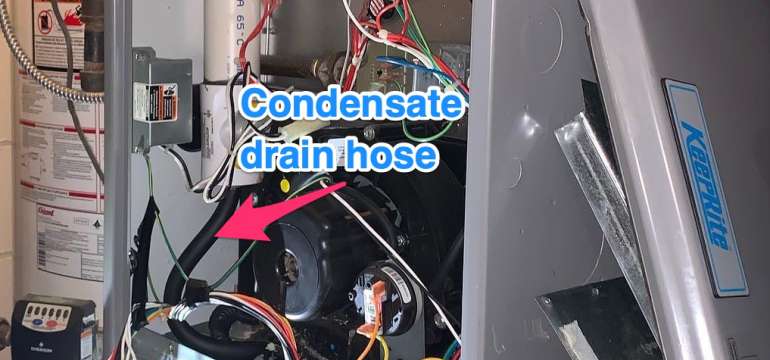
Your furnace’s drain hose slopes down from the PVC exhaust pipe. It can sometimes get clogged up with dirt and gunk. When that happens, drainage is interrupted, and a leak occurs.
If you see water on the floor or inside the cabinet, then you know you’ve got a drainage problem.
The drain line can also get clogged and may cause a condensation backup that leads to a leak. Condensation is created when you turn on your furnace. The condensation accumulated then flows out of the furnace through this pipe. When the pipe becomes clogged, the condensation will start to build up in your furnace.
The solution to this issue is to unclog the pipe. It’s fairly easy to unclog. However, to get access to the pipe, you’ll need to open the gas chamber. If you have no experience doing this, then it’s best to call a professional. If you choose to unclog it yourself, you can find the steps here.
Cracked condensate drain line
If your drain line has a loose connection, a crack, or a hole, it can lead to a leak.
The amount of water dripping from your furnace will hint as to whether it’s clogged or cracked. Clogged pipes usually emit a lot more water around your furnace. Also, when it’s a clogged pipe, water tends to also drip from the furnace vent pipe too.
Although PVC piping is inexpensive, fixing the problem involves taking the furnace apart and putting it back together.
Clogged condensate trap
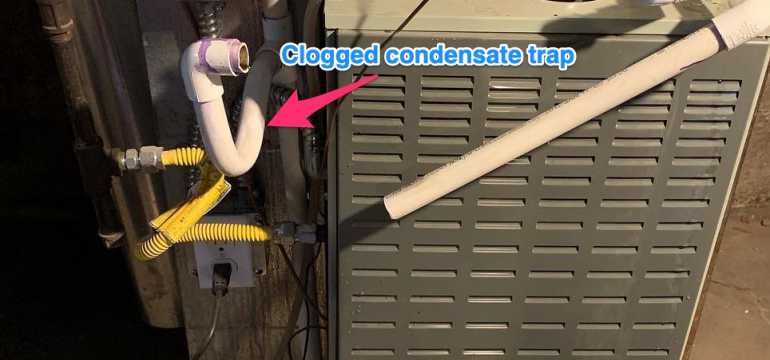
Your condensate trap may also get clogged up and cause a leak. These traps are designed to carry away acidic condensate from your furnace. But things like algae can get into the drainage system and mess up this system.
Condensate pump leaking
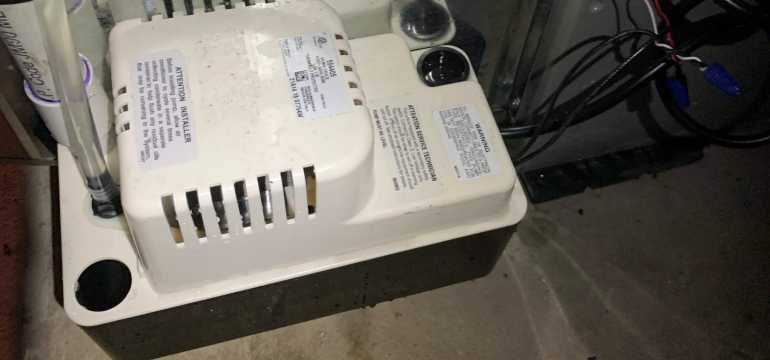
It’s also possible that your condensate pump is leaking. This is where the condensation drains once it leaves your system.
Your condensate pump can also get clogged. You should first check the tank. After removing it, you can fill the tank full of water to test for leaks.
Also, it’s a good idea to check your lines throughout the year periodically to make sure they flow properly.
Additionally, most condensate pumps are only meant to last for between 3 and 5 years. So you may need a replacement if yours is approaching the end of that range.
Inducer assembly leak
Inducer assemblies are where the condensation goes after moving through the drain hose. These can sometimes get cracks in them, which can cause water to leak out of the furnace.
Damaged heat exchanger
Heat exchangers are responsible for extracting heat energy from passing exhaust gases. These gases shed water in the form of condensation as that happens.
But problems can arise in this system when your heat exchanger cracks. This often allows acidic condensation to leak out of your furnace.
Note: A cracked heat exchanger can be an emergency situation. When this happens, your furnace can begin leaking toxic gases into your home.
Non-high efficiency furnace leaking water
If your furnace isn’t a high-efficiency model, then it doesn’t generate any water while running. So if you’re noticing water near the furnace, then it should be coming from another appliance, such as a humidifier or hot water heater.
Also, it could be caused by an external leak or an improper installation.
Improperly installed vent pipe
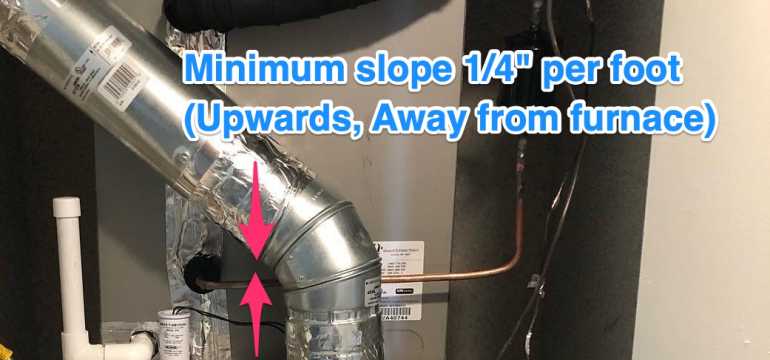
As mentioned above, a standard-efficiency furnace uses metal flue pipe. This metal pipe is made to carry exhaust fumes away from your house that are created during the combustion phase.
The piping carries these gasses before they have a chance to cool and condense into liquid droplets. However, if the pipe is too big or doesn’t have a minimum slope of 0.25 inches per horizontal foot, you’ll have problems.
This is a bad situation. The gas needs to escape. Otherwise, it’ll accumulate in the flue and begin to cool down. Once the gas fully cools, it’ll turn into condensation and leak out. This leakage is not only hazardous to your health, but it’ll also leave a mess in your home. Follow the steps below to see if a leaky vent pipe is the issue here.
- Inspect the flue pipe. Look for moisture on the outside of it.
- Look to see if the pipe has a slope.
- Look for moisture on the ground and around the vent pipe.
- If you do notice a leak or the vent pipe doesn’t have a slope, call a professional. The pipe will need to be replaced.
External leak
The source of your leak may also be coming from outside of your HVAC system. For example, you might have a leaking pipe near your unit. Or you may have a roof leak that’s dripping down from the ceiling to your furnace.
Humidifier leak
Some HVAC systems have built-in humidifiers to help homeowners keep their rooms more comfortable. But these systems can sometimes cause leaks when water lines clog up, break, or crack.
There are several reasons why a humidifier might leak.
- For example, you might have a blocked water panel. This part filters out minerals and sediment from the water that gets passed through it. It needs to be changed out every year to avoid blockage.
- It’s also possible you have problems with your drain. Your entire drainage tube needs to be completely free of obstruction. You might need a technician to come out and make sure yours still is.
- Buildup on the valve can also cause a humidifier leak. This is the part that allows water to flow into the humidifier. Water will leak out of the unit if it’s blocked by buildup.
- Finally, pressure problems can also cause a humidifier leak. An HVAC technician can test your system’s pressure to see if this is the source of your issue.
Unclogging your furnace’s condensate trap and drain lines
For many people, unclogging their furnace’s condensate trap and drain lines will fix their leaking problem.
The exact method for this will depend on the model of your furnace. But the first step is always going to be removing the access panel and locating the trap.
After that, you can follow these steps to unclog your furnace’s condensation trap and drain lines.
1. Asses the severity of the clog
Once you’ve got the access panel opened up, a good first step is assessing how bad the clog truly is. If you can see that it’s going to be really hard to clear out, you might just want to call a professional.
Alternatively, you may see that it’s not very bad. In that case, it could be worth it to proceed with attempting to clear out the clog yourself.
2. See if you can remove the clog by hand
You can try removing the clog by hand first. But this will probably only work if the clog is near the surface.
The process is pretty straightforward. Just poke a finger into the drain and try to dislodge whatever you feel in there.
If the clog goes deeper than that, then you’re likely going to need to use a more intensive declogging method. We’ve included several in the steps below.
3. If you can’t remove it by hand, use a drain snake or brush
Drain snakes and drain brushes can be really helpful for removing deeper clogs. A drain brush will even scrub the inside walls of the drain line to get it clean.
If you don’t have one of these tools, you can try using a long wire as well. For example, you could pull apart a coat hanger and see if that will do the job.
That being said, most furnace pipes are pretty bendy. So a straight wire may not probe deeply enough to fix the clog.
4. Try using a wet/dry vacuum
Sometimes, even a brush or snake won’t get the job done completely. In that case, you may want to try using a vacuum.
If you’re going to do this, make sure to completely shut off the system’s power before starting.
Then attach the hose of the vacuum to the outside part of the drain line. Turn the vacuum on and let it suck the debris out.
5. You may be able to clear it with water pressure
Some drain lines and blockages may respond better to water pressure. Using a garden hose can be pretty effective for clearing out algae and mildew. The best spot to insert the hose is in the opening in the furnace drain pan.
6. Airpower may also help you clear the clog
Airpower can work really well for cleaning out a furnace trap. That’s because it lets you easily get around the bends of PVC tubing that you’ll encounter.
You can do this with just your lungs or by using an air compressor and a nozzle. If you’re going to use a compressor, about 30-40 PSI will do the trick.
7. Finish up by flushing the drain with cleaner
When you’ve finished unclogging the drain, make sure to clean it out before turning it back on. You can use several types of cleaner for this, including dish soap, white vinegar, and diluted hydrogen peroxide.
You should let the cleaning agent remain in the drain for about 30 minutes. Then, flush it out with water and make sure it’s working properly again.
Is a leaking furnace an emergency?
If you have a leaking furnace, you definitely want to make sure to take care of it as soon as possible. Allowing it to proceed unchecked can cause a few issues.
First, the water that leaks out of your furnace will seep into your floors and furniture. This can cause lasting damage and potentially even mold.
Additionally, if the water drips back into your furnace, it can corrode your heat exchanger. This may cause the heat exchanger to crack.
If your heat exchanger cracks, it can be very dangerous. The system may start leaking harmful gas into your home or business.
- What to Do if Your House Smells Like Gas but There’s No Leak - February 6, 2023
- Why Is There a Burning Smell Coming From My Vents? - August 16, 2022
- How to Remove the Musty Smell From Your Air Conditioner - August 16, 2022
